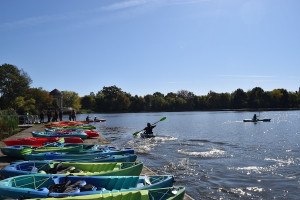The New Chestnut Hill Meetinghouse Is a Luminous Success
Chestnut Hill Friends Meeting built a new meetinghouse this year just steps away from the Quaker faith group’s old building. The new home was essential, says the Meeting’s Nikka Landau: There simply was no more room for the growing community, and the meetinghouse didn’t have sufficient facilities for families that needed to stay there during a time of transition. The new building, designed by architect James Bradberry, is clean and modern — and almost disconcertingly contemporary for a Quaker meetinghouse. But the lack of ornamentation — which keeps the building free of visual clutter — is absolutely consistent with the Quaker aesthetic.
Outside, the meetinghouse is framed by woods and Wissahickon schist that was deliberately uncovered in the building process. Indoors, there’s an enormous, sleekly outfitted kitchen (all the better for potlucks, says Landau); showering facilities for those aforementioned families; classrooms; administrative space; a large multi-use room with a gabled ceiling — in short, 8,500 square feet suited not only to a single congregation but to the Northwest Philadelphia community at large. (There are Mount Airy Learning Tree classes held at the meetinghouse, for example.)
But perhaps the most remarkable element of the new meetinghouse is the Skyspace designed by American light artist James Turrell. On the surface, the space where Quaker meeting takes place looks rather like other Quaker meeting rooms. But there’s something more going on. The curving white walls and ceiling serve as a canvas.
This morning, for example, there was a sunrise viewing. Visitors (myself included) lay down on the floor in sleeping bags or on the pews with blankets looking up at the ceiling. A square in the ceiling was revealed — a skylight without any glass — so that the cold air came in and we were looking directly at a fragment of sky. That fragment changed colors from bright blue to deep green to yellow to almost white — not because the color of the sky was changing, but because of the shifting colored light projected onto the walls around the skylight. Picture the Rothko Chapel if the paintings kept changing colors as the sun rose.
We’re grateful that the union shenanigans (if arson can be called that) didn’t prevent the project from succeeding.


